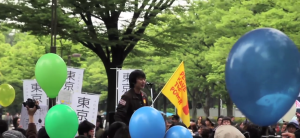On March 11, 2011, an earthquake struck off the coast of Japan, creating a devastating tsunami that swept over cities and farmland in the northern part of the country in Tohoku. Recorded as a 9.0 on the Richter scale, it was the most powerful quake ever to hit the country (in comparison, Montreal’s earthquake last fall registered at 4.5 on the Richter scale). These natural disasters subsequently led to a nuclear emergency, as a result of the Fukushima Daiichi Nuclear Power Station suffering partial meltdowns and releasing radioactive material directly into the atmosphere. Today, the official count of the dead and missing is above 24,000.

The cleverly-titled Radioactivists, directed by German filmmakers Julia Leser and Clarissa Seidel, follows the anti-nuclear demonstrations held in Koenji, Tokyo immediately following the tragedy. Organized mainly by a group of activists known as Shiroto No Ran (Amateur’s Revolt) and a group of political musicians from the Human Recovery Project, the protests featured people from all walks of life, gathering more than 15,000 people by the third demonstration. Combining music and visual arts, the atmosphere was festive rather than tense. These scenes were surprising to many Japanese citizens given the country’s lack of a protest culture. In fact, these were the first major demonstrations the nation had seen since the 1970s.
The anti-nuclear movement in Japan has taken great leaps since the first protests highlighted in Radioactivists. In fact, since 2011, the number of protests in Tokyo against the use of nuclear power have dramatically increased, culminating in 2012 with the country’s largest anti-nuclear event yet (gathering more than 75,000 people).
Japan’s history with nuclear power is a fascinating one. Despite the nuclear bombings in Hiroshima and Nagasaki during World War II, the country’s reliance on the use of nuclear power reactors has grown steadily since the 1960s. Prior to the 2011 Tohoku earthquake and tsunami, Japan generated 30 per cent of its electrical power from nuclear reactors. Thus, when Leser and Seidel turn their cameras towards the endless bright lights in the bustling streets of downtown Tokyo, they implicitly ask: how much longer is Japan capable of maintaining its electric consumption?
Featuring interviews with sociologists, writers, and activists, Radioactivists is thoroughly engaging and intellectually stimulating during its first half. However, the film strays from its narrative focus when the cameras simply follow the protests for long stretches of time. The film’s strengths are showcased most during its aforementioned interviews.
For example, political scientist Chigaya Kinoshita speaks of the initial shock felt by all after the earthquake and tsunami occurred. While the world hailed the Japanese for their so-called stoicism in the face of great adversity, Kinoshita argues that his countrymen simply didn’t know how to react to the situation. It’s safe to say they’re reacting now.
Radioactivists screens Monday Nov. 11 at 7 p.m. in room H-110 – 1455 de Maisonneuve W. Director Karol Orzechowski will be in the audience. The film will be followed by Women of Fukushima. For more information, visit cinemapolitica.org/concordia




